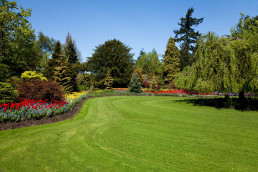Landscape Tips for Fall
Get Your Landscape Ready for Fall
Most people focus more on their lawns and gardens during the seasons when there’s a reason to showcase a beautifully mowed yard full of flowers or veggies. You’re more likely to want to mow the lawn or garden when the weather’s nice, as well. But the leaves will fall soon, so what steps can you take to keep the health of your lawn up during a chilly season?
Get Ready to Rake
Fall arrives in late September, but leaves will be falling throughout October. Clean the yard of leaves to prevent the vegetation beneath from dying. Rake them into bags for composting down the line. Composting can improve soil health and conserves moisture. This is especially important during cold weather.
Mulch is an option, as well. The two are used interchangeably since both serve similar purposes. Compost is decomposed organic matter and mulch is usually made of dry bark chips from trees. Both are packed tightly at the base of plants and are great for protecting rich soil and can be replaced as little as annually.
However, raking leaves for compost matter your chance to create a natural, self-sustained gardening system every year that will keep your lawn tidy-looking in the process.
Lay Down Some Fertilizer
Prior to the first frost is the perfect time to do a little proactive care as the sun disappears and the first frost arrives. Once it does, vegetation will need to survive for months on end.
The first frost is an average estimate of the day of the year when there is a 50% chance of the temperature falling below freezing. Historical evidence of such occurrences is monitored by the NOAA National Centers for Environmental Information. First frost dates can occur as early as late August, so check your local area for dates.
Fertilizer is more so for plants than the soil itself, making it different from mulch and compost. It should be laid before the ground freezes, particularly 2 to 3 weeks prior.
Prep Your Perennials and Annuals
Your lawn’s transition from Summer to Fall is an important time. It has undoubtedly suffered from the summer sun. Most gardeners opt for perennials because of their longevity, while annuals are restricted to a single growing season. Early fall is a great time to plant perennials, trees, and shrubs because the cooler weather allows for them to grow a strong root system before next spring. You will not want to plant these too long after the first frost, so timing is definitely important.
Annuals will undoubtedly die unless moved to an inner area, like a garage or greenhouse before the winter. We suggest grouping them for warmth. Apply mulch and cover with an inch of water (to the soil only) to trap heat. Additional methods like covering your annuals will protect them from an expected frost that day.
Water the Lawn Up Until You Can’t
Late October is when it’s usually time to unplug the sprinkler and irrigation system. This is so that you can maintain access to the pipes and spigots as they will freeze over during the chilly weather. Until then, continue to take good care to water the lawn until the time arrives to unplug the hose and flush the irrigation system out.
Well-watered soil may be the best defense against the first frost than the best efforts with mulch. Soil can hold heat much longer than mulch, which is bound to lose the heat it provides at some point. You want hardy plants that will survive in nutritious soil year-round, and with these tips, you will.
